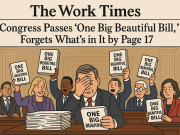The Discount Cliff: Microsoft’s Pricing Shift and How Workplaces Must Adapt
When a vendor the size of Microsoft recalibrates pricing at scale, the shock radiates through finance, procurement, IT and the very processes of work. For many organizations, the era of automatic enterprise discounts is ending—and that will change how companies buy, manage and justify software.
What happened — and why it matters
Microsoft recently signaled that it will eliminate enterprise discounts for certain products, a move that effectively raises list prices for affected clients. The immediate consequence is simple: organizations that depended on volume-based, negotiated discounts now face higher annual software bills or the need to renegotiate commercial terms under a new baseline. Analysts note that this shift appears to have been baked into corporate guidance, meaning the company anticipated and factored the change into its revenue expectations.
This is not a subtle tweak. For large enterprises, mid-market companies and public-sector organizations alike, software licensing is a predictable line item in budget forecasts. Removing or narrowing a long-standing discount structure forces teams to revisit forecasts, reprioritize capital, and, in some cases, delay or rethink planned projects.
The real-world impact on workplaces
On a pragmatic level, expect to see three immediate pain points:
- Budgetary strain: IT and finance will feel the pressure as renewal seasons approach. Contracts that once rolled over with stable pricing will now require urgent attention.
- Procurement disruption: Existing procurement processes—approved vendor lists, multi-year deals, and standard negotiation playbooks—will be challenged. The cadence of purchasing decisions will accelerate as teams race to lock in terms or source alternatives.
- Strategic trade-offs: Leaders will be forced to choose between maintaining current service levels and absorbing higher costs, or reducing spend by consolidating licenses, cutting features, or transitioning to alternative solutions.
Beyond spreadsheets, these changes ripple into everyday operations. Project timelines tied to software availability may slip. Training investments may be deferred. Smaller departments, which could previously rely on corporate licensing banded across the organization, may now see access curtailed.
Why the move makes business sense for Microsoft—and what that means for customers
From Microsoft’s perspective, shifting pricing mechanics can be a rational business decision. A simplified price structure reduces complexity for sales and partners, lifts average selling prices, and aligns revenue recognition with a product-first, cloud-heavy strategy. It also nudges customers toward higher-value offerings—bundles, premium tiers, and cloud services—where margins and recurring revenue are attractive.
For customers, however, that calculus is less flattering. The immediate effect is a hit to predictable total cost of ownership (TCO). Over time, organizations may have to justify higher per-user spending with demonstrable productivity gains, security enhancements, or operational savings elsewhere in the stack.
How procurement and IT leaders should respond—practical steps
This is both a threat and an opportunity. The shake-up offers a forcing function for better governance and more modern procurement practices. Here are concrete, prioritized steps organizations should take now:
- Pause and inventory: Compile an accurate, current inventory of licenses, usage patterns, and renewal dates. Software Asset Management (SAM) programs become invaluable when dollars are on the line.
- Stress-test budgets: Run scenario modeling that reflects the new pricing baseline. What does a 10–30% increase in licensing costs do to operating budgets? Which projects are at risk?
- Renegotiate with context: Approach vendors and resellers with a focused ask: extended terms, staged increases, or bundling that aligns with your roadmap. Leverage renewal windows and show clear usage telemetry to make a case for tailored concessions.
- Optimize before you spend: Identify unused or underused licenses and reallocate or retire them. Rightsizing can blunt price shocks without reducing capability.
- Explore architectural changes: Consider shifting workloads, consolidating SaaS subscriptions, or refactoring to cheaper tiers where feasible. This is a time to question status quo deployments.
- Broaden the vendor view: Evaluate competitive offerings, open-source alternatives, and niche players. Total cost, feature fit, and long-term vendor health matter more than short-term sticker price alone.
- Invest in governance: Strengthen approval workflows, chargeback/showback mechanisms, and business case discipline so future pricing moves are less disruptive.
These steps are not one-time activities. They should form a continuous cycle of review as market dynamics evolve.
Procurement plays to consider
Procurement teams must pivot from transactional negotiators to strategic advisors. That means:
- Building closer alignment with finance and IT to translate usage into budgetary impact quickly.
- Designing contracts with exit ramps and flexibility—shorter terms, usage-based clauses, and clear service-level commitments.
- Using creative commercial constructs such as phased purchases, pilot commitments, or outcome-based pricing to tie spend to measured business value.
Procurement’s new role is to steward technology choices that balance cost, compliance, and capability—often under tighter fiscal restraints.
Wider market consequences
When a dominant supplier alters pricing, alternatives invariably benefit. Expect several market movements:
- Renewed interest in competitors: Vendors positioned as cost-effective substitutes for core productivity and infrastructure stacks will see inbound conversations rise.
- Partner dynamics shift: Value-added resellers and managed service providers will either be pressured to absorb discounts or pushed to differentiate with services and outcome-driven offerings.
- Acceleration of multi-cloud and hybrid strategies: Organizations will prioritize architectural flexibility so they can move workloads to the most cost-effective platform over time.
In essence, price changes become a catalyst for strategic vendor diversification and architectural resiliency.
A cultural and managerial moment
Beyond balance sheets and negotiations, this change invites a cultural shift. Too often, technology consumption is divorced from its operational and financial consequences. The removal of predictable discounts forces conversations that should have happened earlier: What is the measurable value of a given tool? How does it contribute to revenue, risk reduction, or efficiency? Who owns the outcome?
Leaders who treat this as an opportunity to align technology spending with business outcomes will emerge stronger. Those who simply absorb the cost will find margin pressure and, eventually, harder choices.
What success looks like
Success is not merely resisting the price increase; it is moving toward a more deliberate, transparent, and accountable approach to enterprise software. Indicators of success include:
- Clear, real-time visibility into consumption and cost drivers.
- Contracts that provide optionality and tie payments to outcomes where possible.
- IT and procurement operating as partners with lines of business to prioritize spend based on measurable returns.
- Architectures that support portability, so future pricing shifts are navigable rather than paralyzing.
Looking forward
Price policy shifts from a major software vendor should not be viewed as isolated commercial decisions but as systemic cues to modernize how organizations buy and manage technology. While the immediate reaction will be defensive—cut costs, renegotiate, delay—savvy organizations will use this disruption as a spur to tighten governance, rethink vendor relationships, and align spend to outcomes.
Analysts have suggested the change was anticipated in corporate guidance. That foreknowledge does not soften the impact for buyers; rather, it underscores a transition in the software industry toward simpler, often higher-priced commercial models. The result will be a period of adjustment: boardroom debates, procurement retooling, and, for some, meaningful shifts in technology strategy.
In the end, this moment is an invitation. Organizations that welcome scrutiny of software value—and that act decisively—will turn a pricing shock into a competitive advantage. Those that do not will find budgets squeezed and agility diminished.




























